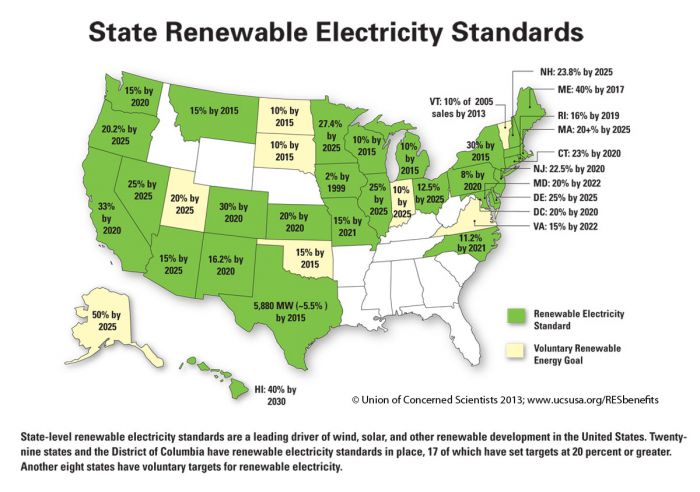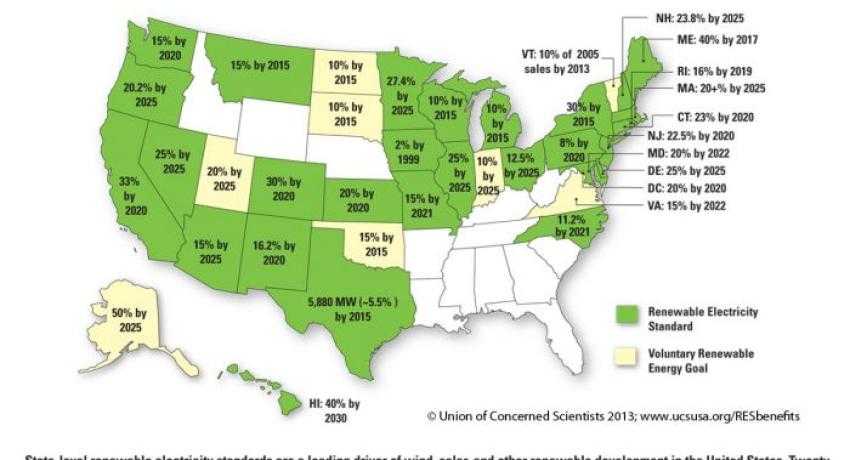Scientists support renewable electricity standards
 A new white paper from the Union of Concerned Scientists (UCS) looks at the success and opportunity that renewable electricity standards (RESs) or renewable portfolio standards (RPSs) are creating for the 29 states (and Washington, D.C.) that have them. The white paper from the advocacy organization supports the development of more RESs across the U.S.
A new white paper from the Union of Concerned Scientists (UCS) looks at the success and opportunity that renewable electricity standards (RESs) or renewable portfolio standards (RPSs) are creating for the 29 states (and Washington, D.C.) that have them. The white paper from the advocacy organization supports the development of more RESs across the U.S.
The white paper comes as an increasing number of RESs in states are under attack. For instance, in North Carolina a bill has been working its way through the legislature that would repeal the state’s RES. The bill comes despite the popularity of renewables in the state, and despite the original bill having bipartisan support.
This is happening across the country. “Of the 30 RES policies in place, 14 were enacted with Republican governors in office and half had either Republican control of both houses of the state legislature or two houses that were split between Democrats and Republicans,” UCS said. “Recently, however, renewable energy has become more politically divisive. Attacks on RES policies are now being led by organizations such as the American Legislative Exchange Council, Beacon Hill Institute, and Heritage Foundation, which often receive funding from fossil fuel interests and use biased analysis to advocate for the repeal or scaling back of RES policies.”
RESs have been successful in their purpose, spreading the adoption of clean energy. “Today, renewable energy technologies—such as wind, solar, geothermal, and biopower—are supplying affordable, reliable, and pollution-free power to the equivalent of some 16 million typical American homes,” UCS said. Citing Bloomberg, the white paper said that in 2012 renewable energy was the largest source of new electric capacity in the U.S., and that by the end of the of year it comprised 5 percent of the U.S.’s energy supply. Up from just 2 percent in 2007.
They’ve also been successful in adding in renewables at little to no cost. “The Lawrence Berkeley National Laboratory, having recently evaluated 2009 and 2010 RES compliance-cost data that were available for 14 states, estimated that all but one state experienced cost impacts of about 1.6 percent or less,” UCS said. The white paper didn’t mention, however, that some of this capacity would have been needed even without adding in more renewables like solar, wind and biomass—which would have led to price increases, too. That’s largely because the RESs have cost-containment measure to protect consumers in the states from rate increases.
Since enacting the RESs the additional costs are also falling. Again, citing NOrth Carolina. USC found that Duke Energy’s residential customers paid, on average, 21 cents per month to support the RES last year—and that’s down from 27 cents per month in 2010. Meanwhile the other large utility in the state saw even deeper decreases, from 55 cents a month in 2011 to 41 cents per month now. In fact, despite claims to the contrary in North Carolina, research has shown that by 2026 its RES is projected to save electric customers in the state $173 million.
In turn, the deployment of wind, solar, and other renewable resources is attracting investments from manufacturers, creating jobs, and producing revenue streams for landowners and local communities, all while providing clean energy that reduces air pollution and helps stabilize the climate.
The white paper concluded that RESs continue to be successful in spreading adoption of affordable, clean energy. “The deployment of wind, solar, and other renewable resources is attracting investments from manufacturers, creating jobs, and producing revenue streams for landowners and local communities, all while providing clean energy that reduces air pollution and helps stabilize our climate.” As such it made a series of recommendations for further development of RESs. It called for adopting strong RESs at the state and national level while expanding existing ones, tracking RES progress and benefits, investing in new transmission capacity, developing responsible and consistent siting regulations and extending incentives for renewables.




